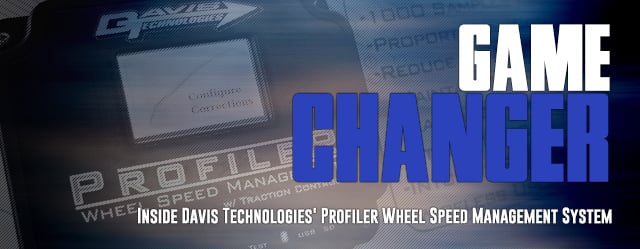Last fall at the Street Car Super Nationals held in Las Vegas, the drag racing world was put on notice – Shannon Davis of Davis Technologies had figured out yet another way to allow a racer to make the most of their combination. As reported right here on Dragzine, Davis assisted John Stanley in achieving the quickest quarter-mile doorslammer pass of all-time with the Stanley & Weiss screw-blown Pro Mod Camaro by lighting the clocks with a heart stopping 5.644 blast during the course of the qualifying sessions for the event.
Davis, famous for his company’s racing traction control systems, was in the process of developing his newest invention, the Profiler Wheel Speed Management system at that event, and had one onboard Stanley’s Camaro during the course of that weekend.
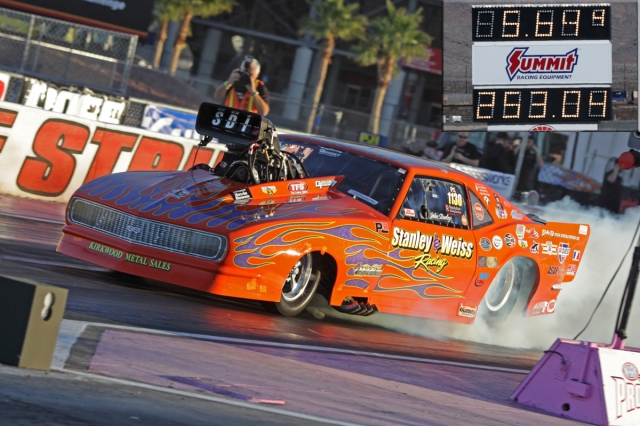
John Stanley shocked the drag racing world last season when he showed off the capabilities of the Profiler at the Street Car Super Nationals in Las Vegas.
With Davis’ help, the Stanley & Weiss team brought Davis Technologies’ latest project to the forefront of the drag racing community – especially since most racers had no idea it even existed.
Its performance was on display yet again at the beginning of this season. At the PDRA’s Spring Open event at Rockingham Dragway, Frankie “Madman” Taylor had the Profiler onboard as he ran the quickest-ever eighth-mile Pro Mod pass with a 3.48 at 216-plus MPH in the PDRA’s Pro Extreme class. Taylor says, “It’s red-hot – I’d put it on any car I could.” Frankie and tuner (and brother) Paul Taylor set the Pro Extreme world on its ear at that event by becoming the first Pro Mod into the 3.40s.
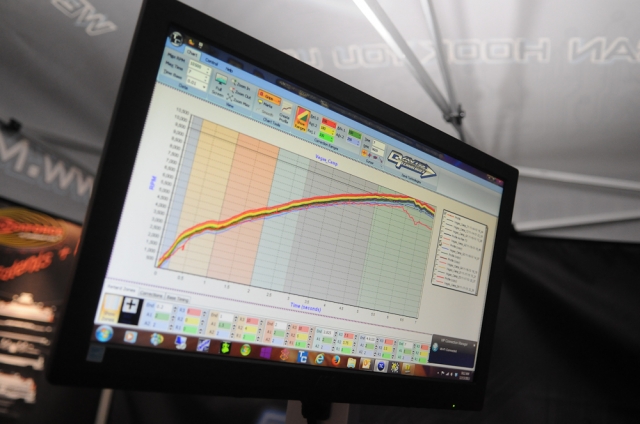
A basic view of a Profiler graph on-screen – the Profiler is set up wherever the tuner wants it to be based on previous run data. The incredible resolution is part of what makes it so successful.
How Does It Work?
The Specifics
The Profiler will hold up to five run profiles at this point, although Davis is debating on adding more storage capability to it in the future.
The profiles are viewed on a laptop computer and can be transferred either through a traditional USB connection or the on-board Bluetooth connection, if your laptop is so equipped.
It can also be ordered with integrated self-learning traction control capability – but the system is still in development at this time, and Davis expects to have it for sale in the near future.
Put simply, the Profiler is a wheel speed management system on a level never seen before. By using the system inputs and Davis Technologies’ proprietary software, the user is able to control the horsepower to achieve a target wheel speed through the use of a driveshaft sensor.
Instead of working to achieve a target driveshaft speed as previous Davis units have done through tuning the power, this unit essentially works in reverse – by measuring the driveshaft input and adding or subtracting power to achieve the results desired by the user. The system allows the user to import data from past runs that can then be manually adjusted to plot out a profile – thus the name Profiler.
“It monitors the driveshaft speed and compares it to a plot that the tuner sets up. The plot can be as high-resolution as 1,000 samples per second, accurate to one RPM. It monitors that plot real-time and compares it to the actual driveshaft speed of the vehicle,” says Davis.
“You go out there, turn loose the transbrake, if it’s above the plot it can remove power and if it’s below the plot it can add power to target a particular wheel speed and run that wheel speed. It’s up to the tuner to set up a realistic wheel speed plot – you’re not going to tune a Pro Mod to go out and run a 3.40 in the eighth – the traction is just not there. But, if you went out and ran a 3.60 yesterday, and going up this morning, you put that plot in there, it might run a 3.58 if you think the track’s there,” he explains.
In Practice
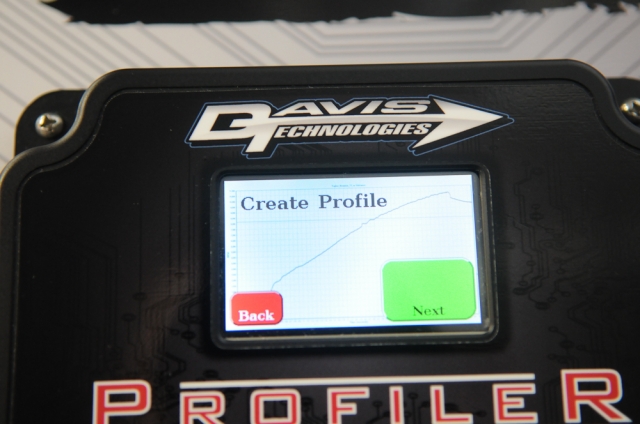
The system uses a color touchscreen interface that will eventually be able to incorporate all of the Davis Technologies products in one unit. It shares the same footprint as MSD’s Power Grid ignition system for ease of installation.
The Profiler software allows the system to import data from past runs in order to plot the profile.
The software creates a range of zones including an average and two each of the upper and lower performance range, allowing the user to select their choice of a range as a base for the profile that the tuner feels will be best in preparation for the next run. This determines how the software will add or subtract horsepower dependent upon driveshaft speed on that subsequent run.
“It does whatever you tell it to do. If you want to put a little hump in on the shift and pick up some wheel speed, then let it, and if you don’t, then don’t,” says Davis.
“Once you get your graph made, it’s actually pretty easy to use. As far as the tuneup goes, you go on the aggressive side of the tuneup, and if you’re too aggressive, it’ll ‘whoa’ you up. You plot off a driveshaft speed that will be optimum for what you want. We started off by using our best runs to date and plotting to them, and then we started moving the graph up from there,” Camp Stanley told us.
The user sets the amplitude for where the timing is adjusted throughout the run, and if the opportunity is there to get after the tuneup in various places on the track, that option is a possibility with the Profiler.

The Profiler makes corrections as necessary. As you can see from this graph, a substantial amount of power was pulled out in the beginning of the run, correcting for track conditions, but just after the car was shifted into high gear the corrections were reduced to basically zero.
On Race Day
A user can plot a “soft” or “hard” launch and then turn up or remove power at any point on the track depending on conditions. The advantage to the Profiler in operation is that if a user sets up too hot of a graph but has a proper rev limiter in place, Davis has found through testing that the car will simply haze the tire all the way down the track rather than lose traction completely and kill the run.
A user can place a dot every ten-thousandth of a second on the graph, or however they wish to design the graph for their particular combination with the data they have to work from – the Profiler’s software can account for that incredibly precise level of control. Timing is advanced and retarded as needed to follow the profile set up by the tuner.
“If a user sticks the tire harder than they thought and the car slows down, the Profiler can give the car power to keep it out of tire shake – and that’s a big deal. Now guys can just tune ’em hot, and if you put the Profiler in a realistic place, the car’s just going to go down the track,” says Davis.
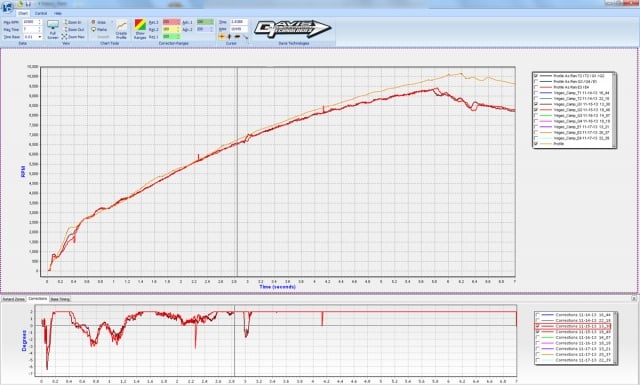
This graph compares runs made on the same day. The orange line at the top is the Profile, the brown and red lines on both graphs are the runs themselves. Note how the red line spikes (caused by a bad plug wire, not an actual driveshaft issue) above the Profile in two instances (2.3 sec and 4.1 sec), and at the bottom you can see how aggressive and how quickly the Profiler was in making corrections.
“This is the quickest-acting and most comprehensive traction control we’ve ever used. In small tire drag racing, it’s very hard to find anything that reacts quick enough to be effective without totally killing the pass. Davis has changed that perception with the Profiler,” says Drag Radial racer Brad Edwards. Edwards and Davis work closely together as Edwards lives just a short trip down the road from Davis Technologies, and the Profiler has been extensively tested in Edwards’ stock-suspension, twin-turbo big-block Mustang. The car is one of the quickest and fastest stock suspension cars on the planet.
Upcoming Enhancements
The plot can be as high-resolution as 1,000 samples per second, accurate to one RPM. – Shannon Davis, Davis Technologies
Davis is investigating how to build the Profiler into a complete vehicle management system, incorporating the Profiler, his company’s Bump Box, and even their Traction Control units and other products yet to be designed into one do-it-all unit. The idea is to simplify the process for the end-user – they purchase one box, and then will have the ability to subsequently “turn on” each item. With one piece of hardware the user will be able to add additional functionality as it’s required by the combination.
Since there is plenty of room inside the solid-state unit for the hardware to operate all of these items, it would be a simple software upgrade each time the user wants to make a new purchase. For example, if a user purchased the basic Profiler wheel speed management system for a turbo setup, adding a Bump Box would be as easy as dialing up Davis Technologies to order it, then downloading a software update to turn the new item on.
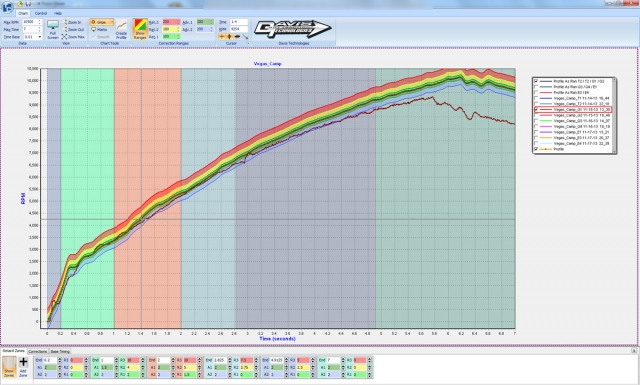
The left axis is driveshaft RPM and the bottom axis is time. At the very bottom of the screen is where timing adjustments are made in the zones of retard – the color of each zone corresponds with a section on the main graph to simplify the tuning process.
In Conclusion
Davis says that the system will be available from an entry-level Profiler unit to a completely-loaded Pro version, priced in line with their currently offered products.
The Profiler is a piece of hardware within the car that will allow you to evaluate your data, set up a graph to improve your subsequent performance, and help you make better runs more consistently. Well, it’s not really that simple, but almost – and Davis Technologies is working every day to make it better. So far, the equipment has revolutionized Pro Mod racing, and as the technology trickles down it will make for better racing wherever it lands.



